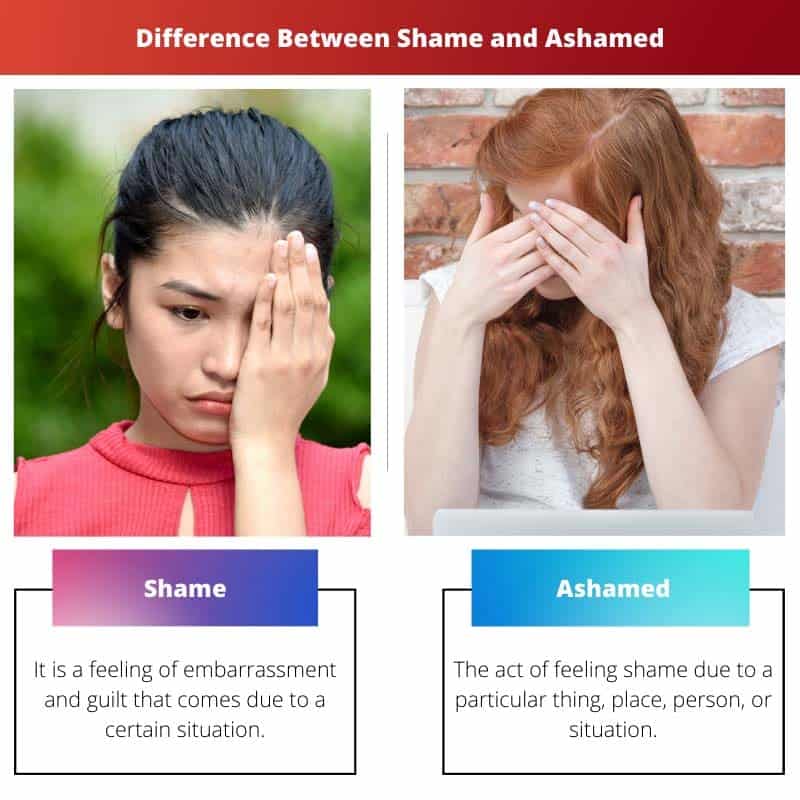In English sentences, Shame is used as a noun to describe the painful feeling of embarrassment and guilt.
A noun is a part of speech used to identify a certain group of objects, people, places, etc., whereas Ashamed is used as an adjective that describes and modifies the meaning of a noun.
Key Takeaways
- Shame is a painful emotion experienced when one feels unworthy or inadequate.
- Feeling ashamed is a personal reaction to one’s actions or behaviour considered wrong or embarrassing.
- Shame can be internal and external, while shame is an internal, self-directed emotion.
Shame vs Ashamed
In English, shame refers to the feeling of guilt or embarrassment from an unintentional wrong deed. In this emotion, the person regrets the action that led to the consequences. Ashamed refers to feeling shame from a particular incident, person, place or situation.

Shame comes with a painful feeling of distress caused due to unintentional or intentionally wrong behavior. If a person has shame, they have regret in mind about the unfortunate situation or actions that might have led to the situation.
Shame is one of the reactions that are common after trauma. A person experiencing trauma might also be facing emotional distress and health problems.
Ashamed means guilty or embarrassed because of one’s actions or characteristics. It can even be the reluctance to accept some fact due to fear of facing humiliation.
The feeling of being ashamed might belong to a past incident that the person has fallen victim to. Some incidents, which can also be seen as minor traumas, cause a person’s withdrawal from a certain person, activity, or place.
Comparison Table
| Parameters of Comparison | Shame | Ashamed |
|---|---|---|
| Meaning | It is a feeling of embarrassment and guilt that comes due to a certain situation. | The act of feeling shame due to a particular thing, place, person, or situation. |
| Parts of speech | It is used as a noun in sentences. | It is used as an adjective in sentences. |
| Effect on person | It might be succeeded by anxiety or emotional distress. | It causes withdrawal from things that might lead to creating a particular situation. |
| Influencing factor | Even minorly awkward situations can lead to a feeling of shame. | A person feels ashamed when they are guilty about the things happening. |
| Example | The kids hung their heads in shame when the Principal scolded them. | She was ashamed of herself for behaving this rudely. |
What is Shame?
Shame is seen as a self-conscious emotion associated with guilt, withdrawal motivations, and feelings of distress and worthlessness. Shame comes with a feeling of sadness caused due to unintentional or intentionally wrong behavior.
If a person has shame, they have regret in mind about the unfortunate situation or actions that might have led to the situation. Shame is one of the common after trauma.
A person experiencing trauma might also be facing emotional distress and health problems.
It is a painful feeling mixed with emotions of regret, dishonour, and self-hate sometimes. It can be alerted when it is too repetitive. It is necessary to feel guilt about your wrongdoings but for a certain time and certain measure.
A good person might feel shame when they get caught in something that they did not really want to be a part of. For example, if a good student had been unwell and was unable to prepare for exams, he cheated and got caught.
This incident might seem minor, but for that person, it could be a matter of guilt and might bring his reputation down among his colleagues. Such situations can bring a feeling of shame and embarrassment to people.

What is Ashamed?
Ashamed is the feeling that comes with remorse due to the feeling of shame. It comes with a sense of inferiority or regret due to some stupid actions.
Ashamed is being guilty or embarrassed because of one’s actions or characteristics. It can even be the reluctance to accept some fact due to fear of facing humiliation.
The feeling of being ashamed might belong to a past incident that the person has fallen victim to. Some incidents, which can also be seen as minor traumas, cause a person’s withdrawal from a certain person, activity, or place.
Let us see the meaning of ashamed more clearly in a sentence, for example, She felt ashamed of losing her temper like that. The feeling of being ashamed might also come after an incident has happened.
Sometimes, people get carried over with their emotions and do things impulsively without thinking about the harm that it might bring. This leads to a feeling of self-disgrace that strikes after the action has happened.
One can be ashamed of the certain body or facial characteristics that they possess due to the comments that they have heard on their appearance. These situations lead to withdrawal from social situations and lower confidence.

Main Differences Between Shame and Ashamed
- Shame is a feeling of embarrassment and guilt that comes due to a certain situation. Being Ashamed is the act of feeling shame due to a particular thing, place, person, or situation.
- Shame is used as a noun in sentences. Ashamed is used as an adjective in sentences.
- The feeling of shame might be succeeded by anxiety or emotional distress. Being Ashamed causes withdrawal from things that might lead to creating a particular situation.
- Even minorly awkward situations can lead to a feeling of shame. A person feels ashamed when they are guilty about the things happening.
- For example, The kids hung their heads in shame when the Principal scolded them. She was ashamed of herself for behaving this rudely.




